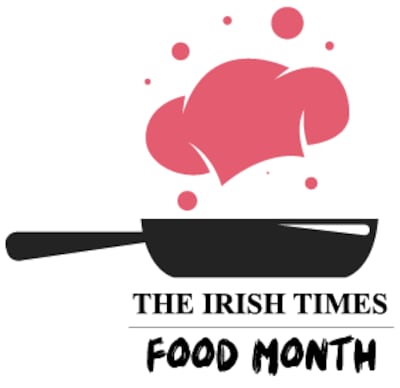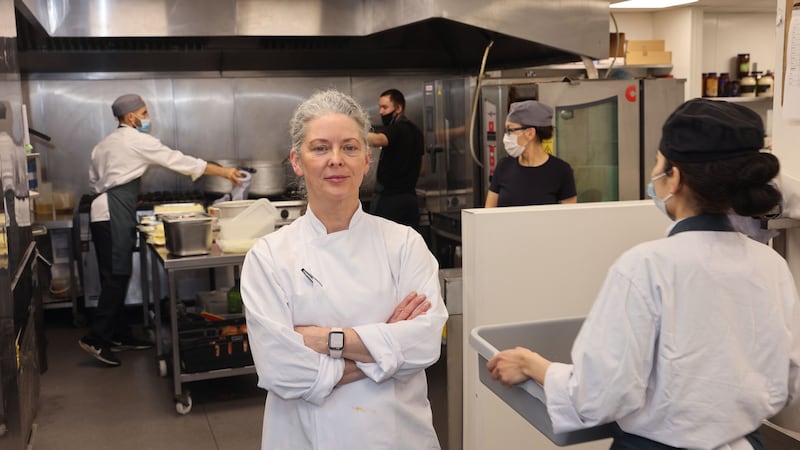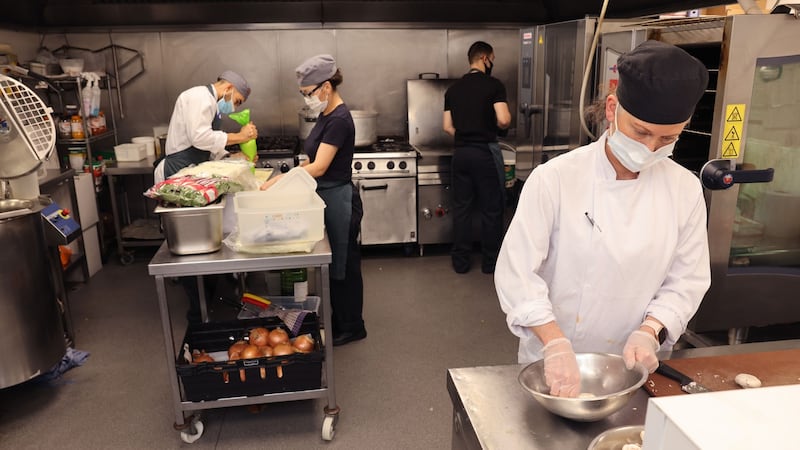Professional kitchens are tough work environments, and even tougher for women. There is growing awareness of gender inequality among chefs and increasing efforts to address it. Watching sea changes unfold, and movements such as Waking the Feminists, experienced chef Mary Farrell “started questioning why there were so few women in the industry, wondering what is going on in our profession that we don’t see enough women coming through, especially at the top level”.

An executive chef with decades of experience Farrell has seen a lot, “front of house and back of house, I managed restaurants, I ran my own business”. Aware there was little information about cheffing in Ireland – no database with details of gender breakdown, roles etc – she began research, and last year completed a PhD at TU Dublin on gender inequality in the Irish chef profession.
Sometimes it's hard to relate to the males when all they do is talk about football and which girl they're having sex with now
The findings quantify some of how the sector is structured. It also includes personal comments from those working in it, some of which may go part of the way to explain why there are so few women chefs here – 69 per cent of chefs in Ireland are male. At the top tier, 90.5 per cent of all executive head chefs are male while 79 per cent of all head chefs are male.
“Women aren’t as included in the workplace like men are,” says a survey respondent. “They talk amongst themselves and usually get bumped up quicker due to the males getting on with the male head chefs. Sometimes it’s hard to relate to the males when all they do is talk about football and which girl they’re having sex with now.”
That experience of a young female commis chef in a casual dining kitchen is echoed by others, informing the qualitative aspect of Farrell’s research. “I am a female chef and people you work with, over and under, make jokes about being a woman in a kitchen and sexual comments towards you,” reports an older female pastry chef in a fine dining kitchen. A male head chef working in casual dining agrees: “there are too many sexual references or jokes in the workspace”.
Even before the Covid pandemic there was a shortage of chefs in Irish hospitality. Issues of fairness aside, if professional kitchens are considered to be inhospitable environments for women, the sector is already on the backfoot when it comes to recruitment or retention.
For her research, Farrell surveyed 475 people (236 males, 239 females), representing two per cent of the chef population here. The responses were weighted to reflect the gender breakdown of the Irish chef population represented in 2016 CSO data.
While respondents were broadly in line with the age and geographical profile of chefs, she weighed the survey against 2016 CSO census data to reflect the gender breakdown of chefs.
Some 90 per cent of chefs in Ireland work in four types of kitchen: industrial or catering kitchens; casual dining including restaurants and bars; hotels; fine dining.

The research shows the majority of women work in lower grade kitchens and lower grade chef roles, where 73 per cent of all pastry chefs are women, 67 per cent of all chefs de partie are women and 58 per cent of kitchen managers are women. While men are more evenly spread across kitchen types, they dominate in fine dining and hotel kitchens, where almost 50 per cent of all male chefs work, compared with only 33 per cent of the total female chef population.
Significantly, men dominate in key leadership roles here: 97 per cent of executive head chefs in hotels are men. In fine dining over 83 per cent of all head chefs are men.
Just 31 per cent of chefs are female; 56 per cent of women identified gender inequality as an issue, where only 28 per cent of men did (showing “it wasn’t really an important issue for men”, says Farrell). But even more women pastry chefs (67 per cent) and women hotel chefs (64 per cent ) pointed to gender inequality.
While a number of celebrated women chefs have high profiles here, that visibility doesn’t extend into the sector’s kitchens. Farrell says there are several reasons for this, including unequal promotions that lack transparency, lack of chef leadership training, lack of compulsory paternity leave, unequal pay, and hostile work environments, with a masculine culture of sexual harassment/strict discipline/long working hours.
Farrell sums the pattern up: “Men dominate all leadership roles, particularly in hotel and fine dining kitchens. In an ideal world promotion is dependent on chefs’ skills and ability. But lack of transparency in promotion pathways permits bias based on gender to influence promotion in kitchens, where women are less valued.
“Perception of women’s value and worth play a key role in determining access to promotion, particularly in hotels and fine dining. Male chefs in those environments are more likely to hold stereotypical views of women chefs, identifying themselves as breadwinners and women as nurturers. This results in believing women are less capable because of their gender, and an assumption that all women will have children and caring roles, and are therefore passed over.
“Men are elevated to senior roles while women remain in the feminine pastry and lower status roles. In fine dining, long working hours allow discrimination based on the possibility that women might desire to have a family. Acceptance of this results in the system remaining unchanged, and perpetuates gender inequality.”
Prof Pat O’Connor, Farrell’s external PhD supervisor and emeritus professor of sociology and social policy at UL, is an academic with significant heft. She sees in cheffing the same pattern she sees in other male-dominated areas, from higher education to politics.
Despite my experience and culinary education, I am never asked for input on the savoury food section. I am not called or considered a 'chef' by restaurant staff
“Men are less likely to think gender inequality exists because it doesn’t affect them. The supreme irony is that it’s an area which is stereotypically seen as very female – cooking – but men are dominating in leadership positions, and higher status areas. It’s a classic pattern. Areas, such as pastry roles here, are seen as ‘suitable’ for women and it becomes a cul de sac; it’s very difficult to move to being a chef in more elite areas. The career track doesn’t run from pastry to fine dining or leadership as a top chef. Women become locked into areas that are going nowhere.”
Then there’s the culture of cheffing, none of it new, nor exclusive to Ireland, seen in international research and epitomised by Kitchen Confidential, Anthony Bourdain’s account of a profane, raunchy, testosterone-filled culinary culture; one which is now recognised as hostile and abusive, particularly for women.
One respondent, a young hotel pastry chef, highlighted a culture of silence where women are devalued: “in the kitchen, men feel like they can treat you how they like because at the end of the day, kitchen sticks together”.
Other women identified lack of respect and recognition for their roles and their work. Another pastry chef, in an industrial catering kitchen, said “despite my experience and culinary education, I am never asked for input on the savoury food section. I am not called or considered a ‘chef’ by restaurant staff.”
Said a casual dining chef de partie: “I was not treated fairly for the work that I did compared to male chefs” while a hotel commis chef observed “a very macho environment, women treated like they know nothing, opinions not respected, and I find there are less men and they do less work yet are employed in the higher roles, while the women are working the tougher jobs, and are more inclined to pull their weight and own up to any issues that come about. The men do the bare minimum yet are taking home a bigger pay packet!”
Chef Máirtín Mac Con Iomaire supervised Farrell’s research at TU Dublin, where he lectures in culinary arts. He calls it “a culture that is changing, dramatically and quickly”. But he wasn’t surprised by the findings, seeing it replicated across society and other professions, “where starting a family coincides with key career stages, and societal norms see the burden of caregiving disproportionately falling to women”.

Some restaurants have cut back on opening hours or days because of staff shortages and a growing awareness of work-life balance, Mac Con Iomaire says. Restaurants need to be more flexible in working hours, if that’s what’s needed. The hierarchical Brigade Kitchen structure, which may be problematic, is dying out, he says, though it remains a necessity in large hotel kitchens with multiple dining rooms.
One theme emerging in the research was a perception that some practical classes were biased at third level training level, where women were seen as less capable than men in hot cookery classes and encouraged towards pastry instead. “Some of our lecturers in practical classes look down on girls . . . and tend to be ‘surprised’ when we achieve an equal (if not superior) end result in a dish.” “Practical lecturers treat male and female students differently, underestimating the ability of female students.”
Mac Con Iomaire believes such comments “may be outliers. I don’t think it’s widescale” in education. But he’s not complacent: “We do need to hold a mirror up to ourselves, and catch unconscious bias.” While culinary arts at third level is “very egalitarian” and there is balance among students with “50/50 coming in”, he says, there may be some self-selection, with female students choosing pastry and nutrition courses.
Farrell says the staff shortage crisis is a persistent headline for the chef industry in Ireland, throughout the Celtic Tiger boom and now coming out of the pandemic. There are multiple reasons and no easy solutions. “We should ask why the profession remains an unattractive career choice for women. We haven’t addressed this glaring elephant in the room. Now is the time.”
There’s some evidence of change emerging, and Farrell suggests an impressive suite of actions to tackle what seems endemic. She says reintroducing a joint labour commission for hospitality is key. Other suggestions include dynamic national tracking to monitor career progression, a gender-inclusive code of conduct, unconscious bias training for educators, mandatory paternity leave, inclusive leadership training, an independent body to monitor gender inequality, and education for head chefs in managing kitchen teams.
Mac Con Iomaire believes “cultural tropes within the industry are being broken down”. Farrell says: “We need something to start a level playing field. There may be some very old-style chefs, and there are definitely some very good head chefs now, that know how to run kitchens.” There are grounds for hope.













